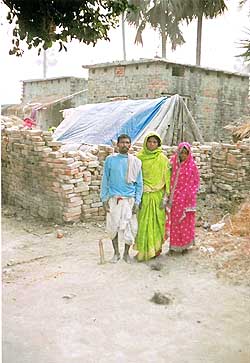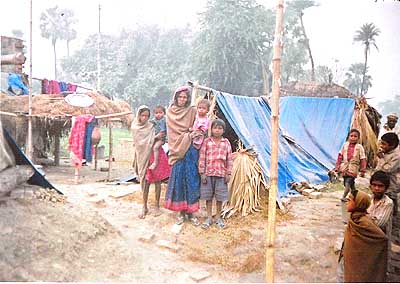 The distress of flood-affected villagers does not pass away with the flood waters, it stays on for a long time. This is particularly true for floods which were as destructive as the floods of North Bihar in July-September 2007. The distress of flood-affected villagers does not pass away with the flood waters, it stays on for a long time. This is particularly true for floods which were as destructive as the floods of North Bihar in July-September 2007.
In the course of a survey of flood-affected villagers in eleven rural hamlets of East Champaran district, we spoke to over 200 people and learnt that the overwhelming majority of people suffer from hunger and malnutrition, do not have access to quilts or blankets and the houses of villagers damaged in floods have not been repaired yet.
 As a cruel cold wave has started, how will the greatly weakened people survive the combined impact of hunger, malnutrition and exposure to cold wave? As a cruel cold wave has started, how will the greatly weakened people survive the combined impact of hunger, malnutrition and exposure to cold wave?
NOW is the time to step up the relief work. Any delay will be simply too costly.
Meera Devi of Semra village, in Ramgarhwa panchayat (Motihari block) said that at present she does not have even a grain to offer to God for worship.
Ambiya Khatun simply burst out and started weeping uncontrollably when we were discussing the food situation in her hamlet of Kathaan panchayat (Motihari Block). Her tears said more than any words can. She and her neighbours don't have any food stocks. They can eat only on the days when they get employment, or else they add to their debts which are already high.

Employment is difficult to get in the flood-devastated economy of North Bihar where even reasonably well-placed farmers have been reduced to distress conditions. In the villages where we went, during October to December (post-flood days) no work has become available under the employment guarantee scheme, the people said. Heavy machinery is being used in road construction and other development work, depriving people of much needed work.
Ambiya Khatun's four member family as well as several other families of her village are in fact not even living in their regular houses. Their houses fell down or were damaged heavily in floods, and so far no help has become available for repairs or new houses. So they are living in ramshackle, improvised huts which they have constructed on the embankment where they had sought shelter at the time of floods. Such shelters, or mere pretence of shelters, cannot protect them from cold-wave.
Maneshwari of Semra hamlet said - "You are asking us whether we have quilts or blankets. The reality is that this year we do not have even pual (paddy husk). Earlier at least even the poor had some pual to protect them from the cold weather. But this year as the entire paddy crop was washed away by floods, so there is also a glaring shortage of pual."
This also means a severe shortage of fodder for cattle and other farm animals. In fact in the village we visited, many people said that while they had lost cows, bullocks, buffaloes and goats in the flood waters, several times more animals have been lost in the post-flood days due to shortage of fodder, fodder getting spoilt or fungus-infected and the resulting illness.
Relief sent by the government, UNICEF and voluntary organisations particularly Action Aid has also reached people, but such is the enormity of the distress that it needs to be stepped up greatly as soon as possible to meet the special needs of people in the winter months.
next page... Some relief has reached people, but it is not adequate
Tragedy of Threatened Villages
|